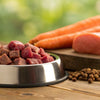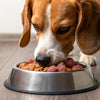Can a Raw Food Diet Make My Dog Sick? Exploring the Risks and Realities
- Houndsy
Table of Contents
- Introduction
- Understanding Raw Food Diets for Dogs
- The Health Risks of Raw Food Diets
- Mitigating the Risks of Raw Dog Food
- Evaluating the Alternatives
- Conclusion
Introduction
As pet parents, we all want the best for our furry companions. In recent years, the trend of feeding dogs a raw food diet has gained significant traction, fueled by the belief that uncooked food, akin to what their ancestors consumed in the wild, enhances health and vitality. However, an important question looms: can a raw food diet make my dog sick?
Statistics reveal that approximately 25% of raw pet food samples tested by the FDA were found to harbor harmful bacteria like Salmonella and Listeria. This data raises valid concerns about the safety and efficacy of raw diets, not only for our pets but also for ourselves. In this post, we will meticulously explore the implications of feeding raw food to dogs, uncovering both the potential benefits and significant risks.
Our primary aim is to empower you with well-researched information about the raw food diet for dogs, highlighting how it can be both a choice for some and a potential health hazard for others. We will discuss the nutritional adequacy of raw diets, the health risks involved, strategies to mitigate those risks, and the best practices for feeding your dog a healthy, balanced diet. By the end of this article, you will be equipped with insights to make informed decisions regarding your dog's feeding regimen.
Understanding Raw Food Diets for Dogs
What Constitutes a Raw Food Diet?
A raw food diet for dogs typically comprises uncooked meat, organ meat, bones, fruits, and vegetables. Advocates argue that these components are biologically appropriate for dogs, as they closely resemble their ancestral diet. However, raw diets can vary considerably based on source, formulation, and preparation methods.
-
Commercial Raw Diets: These include pre-packaged raw foods sold in grocery stores or directly from manufacturers. They may come as frozen patties, freeze-dried formulations, or raw-coated kibbles.
-
Homemade Raw Diets: This involves pet owners preparing their dog's food from fresh, raw ingredients. It offers more control over what the dog eats but requires substantial knowledge about nutrition to ensure balance.
Dogs and Their Dietary Requirements
Despite their carnivorous roots, domestic dogs are omnivorous and have evolved to digest a variety of foods, including grains and vegetables. They rely on nutrients such as proteins, vitamins, and minerals for optimal health. Raw diets are often perceived to fulfill these requirements effectively, yet they can also lead to deficiencies, especially if not formulated correctly.
Essential Nutrients for Dogs:
- Proteins: Contribute to muscle growth, repair, and overall cellular function.
- Fats: Source of energy and crucial for skin and coat health.
- Carbohydrates: Important for digestive health and energy.
- Vitamins and Minerals: Necessary for a multitude of bodily functions, including immune system support.
While raw diets may be rich in protein, they are often criticized for being deficient in essential vitamins and minerals, which can result in long-term health issues.
The Health Risks of Raw Food Diets
Bacterial Contamination
One of the most significant concerns regarding raw dog food is the potential for bacterial contamination. Research indicates that many commercial raw diets are susceptible to pathogens that can affect both dogs and their human companions.
- Salmonella and Listeria: These bacteria are commonly found in raw meats and can lead to serious illnesses in both pets and humans. Symptoms in dogs may include vomiting, diarrhea, and fever, while in humans, they can cause gastrointestinal distress and more severe complications, particularly in vulnerable populations (children, elderly, immunocompromised).
Nutritional Imbalance
Imbalances in nutrient intake are common in raw diets. Without careful planning, dog owners might inadvertently provide their pets with an incomplete or unbalanced diet, which can lead to:
- Bone Health Issues: Feeding an unbalanced raw diet can lead to calcium deficiencies, resulting in potential bone problems and developmental issues in puppies.
- Gastrointestinal Disorders: Changes in diet can disrupt the gut microbiome, leading to diarrhea or constipation.
Mitigating the Risks of Raw Dog Food
Safe Handling Practices
If you choose to feed raw diets, implementing rigorous handling protocols is essential to minimize risks. Here are vital practices to consider:
- Hand Washing: Always wash your hands thoroughly with soap and water after handling raw meats.
- Surface Sanitation: Disinfect countertops and utensils after meal prep to prevent cross-contamination.
- Storage: Store raw food in a designated area, away from human food, and ensure proper thawing techniques.
Choosing Quality
Selecting high-quality raw products can make a difference. Look for reputable brands that perform rigorous testing for bacteria and nutrients. Raw dog food should also meet AAFCO (Association of American Feed Control Officials) nutritional standards to ensure it is formulated correctly.
Consulting Your Veterinarian
Before making any significant changes to your dog's diet, it’s crucial to discuss your plans with a veterinarian. They can provide tailored advice based on your dog’s specific needs and health condition.
Evaluating the Alternatives
For pet owners concerned about the risks associated with raw diets, several alternatives can provide health benefits without the associated dangers:
- Commercial Cooked Diets: Look for high-quality cooked meals that are balanced and meet nutritional standards.
- Freeze-Dried Raw Foods: These products are treated to eliminate harmful bacteria while still preserving the nutritional integrity of raw ingredients.
- Homemade Cooked Meals: Preparing balanced meals at home can ensure your dog receives wholesome, safe food.
Conclusion
Turning to a raw food diet for your dog can seem appealing, especially with claims of better health and vitality. However, it’s crucial to weigh the potential benefits against the significant risks, particularly the hazards posed by harmful bacteria and nutritional imbalances. If you decide on a raw diet, implementing safe handling practices and ensuring nutritional completeness is essential.
At Houndsy, we believe that the feeding ritual is an opportunity to bond with our pets and create an enjoyable experience for both. For those who prefer convenience paired with thoughtful design, our Houndsy Kibble Dispenser transforms the way you feed your dog, ensuring perfect portions without messy clean-ups. For more details about our innovative product, visit our Houndsy Kibble Dispenser page.
FAQs
Q1: Can I mix raw food with kibble? A1: While some believe that mixing raw and kibble can upset digestion, many dog owners successfully do it. However, monitoring your dog’s response is essential.
Q2: How do I know if my dog is sick from a raw diet? A2: Symptoms of illness may include vomiting, diarrhea, lethargy, or changes in behavior. If you observe these signs, consult your veterinarian immediately.
Q3: Are there safer raw food options? A3: Yes, look for high-quality commercial raw products that are tested for pathogens. Freeze-dried options are also a safer alternative.
Q4: Is it necessary to consult a vet before switching to raw food? A4: Absolutely. A veterinarian can guide you based on your dog’s health needs and ensure a balanced diet.
Q5: Can dogs die from eating raw food? A5: While it is rare, health complications from bacterial infections or nutritional imbalances can arise from poorly managed raw diets.
Q6: What should I do with leftovers? A6: Discard leftovers immediately and clean bowls thoroughly to prevent contamination.
Now that you’re informed on the potential risks and benefits of feeding your dog a raw food diet, it’s time to consider what’s best for your pet’s health and well-being. Make feeding a joyful and safe experience, ensuring your beloved pet thrives, whatever diet you choose!













